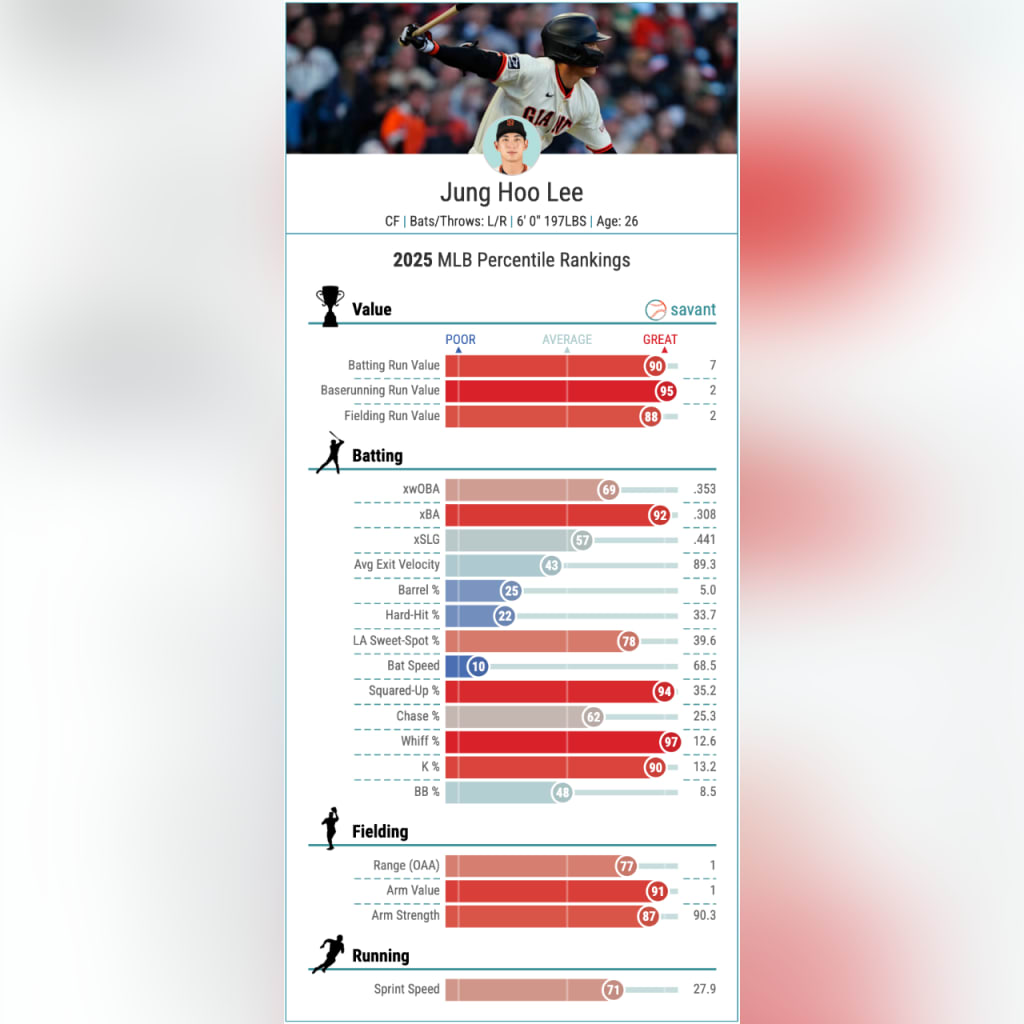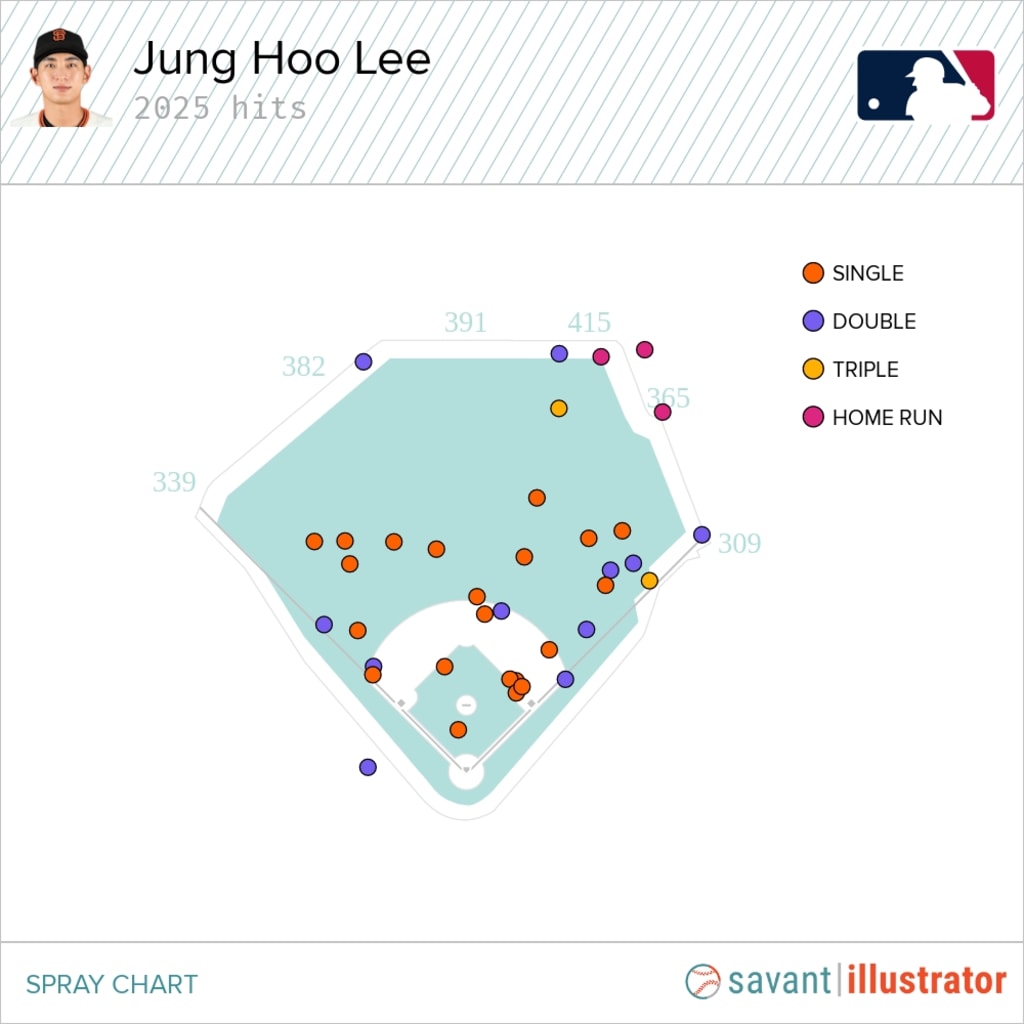Watch Jung Hoo Lee rake in San Francisco, and you'll see one of the more unique swings in Major League Baseball. His swing marches forward like a military procedure.
Step 1: Lee starts standing tall and spread out in the batter's box, his hands high over his head and his front foot wide open toward first base.
Step 2: As the pitcher starts his delivery, Lee steps sharply in and freezes, now almost square to the pitcher but coiled like a spring. He holds his position there.
Step 3: Finally, as the pitch is released, Lee steps a second time -- he strides toward the pitcher, uncoils the spring and fires off the swing that's produced a .316 batting average, .893 OPS and National League-leading 11 doubles in his breakout second season in the Majors.
This is a style of hitting that you won't often see in MLB. Lee combines the wide open batting stance of left-handed hitters like Rafael Devers with the toe tap used by Shohei Ohtani and the uppercut-style swing path used by Freddie Freeman, but instead of flowing through those stages of his swing in one gradual motion, the Giants' budding star goes piece by piece, one step at a time.
But the mechanical sequence of Lee's swing all boils down to one fundamental thing:
"Timing," Lee said through interpreter Justin Han. "It's all about the timing. Whatever the pitcher gives me, it's all about the timing. And when the timing is good, I make the right quality of contact on the bat against different pitches."
Knowing Lee's baseball genealogy, you might guess he got his swing from his father, Korean baseball star Jong Beom Lee. But that's not the case. Lee's father, the "Son of the Wind," hit over 200 home runs in his career in Korea and Japan. But Lee, the "Grandson of the Wind," did not inherit his swing.
"My dad would never tell me how to play baseball, so it's something that I made," Lee said. "And also, my dad and I have a different kind of motion going into the swing. It's something that I came up with.
"It's a personal feel that I have about baseball and I can't really put it into words."
Lee has used the same idiosyncratic swing -- the open stance, the preliminary step in, the freeze, the second step to the pitcher, the uncoil -- since his days at Whimoon High School in Seoul. He used it throughout his seven-year KBO career, including during his MVP run in 2022.
"As a high school kid, that's how I started hitting," Lee said. "And then it just stacked up, became a mechanic. Every year I felt like an improvement, and now here I am with that swing.
"It's something that I just kept on doing. Becoming a professional baseball player, my KBO team would always let me know that this is how you should be hitting. And also, the results always followed. So there was no need for me to change anything."
Every piece of that swing contributes to Lee's ability to get the right part of the bat to the baseball at the right time.
The open stance is simply to see the baseball better as he faces pro pitchers with a wide range of deliveries and stuff. Lee starts 41 degrees open toward first base, per Statcast's new batting stance data, the fifth-most open batting stance of any left-handed hitter in the Majors.
He's even gotten more wide open in 2025 than he was in his debut in 2024, when his stance was 33 degrees open. Big league pitchers are nasty. Every little bit of visibility helps.
And Lee's pitch recognition has proven to be a strength this season. It's why he can cover any pitcher and pitch type. Lee is batting .304 against righties and .342 against lefties. He's batting .328 against fastballs and .302 against breaking and offspeed pitches.
"I used to have a straight stance, not the side stance that I have," Lee said. "It wasn't as open as this. But as soon as I became a professional, I started facing a different kind of variety of pitchers. They would start to throw in a lot, so that's when I started to change. It was just about the environment and all the pitchers that I started facing throughout the years. I never meant to hit like that specifically, I just naturally changed like that."
Once he is ready to hit, Lee draws his front foot back in, timed against the pitcher's delivery. He might start 41 degrees open, but he's less than half that by pitch release. When Lee starts the second stage of his swing and prepares to take his second step toward the pitcher, he's only 20 degrees open.
From there, Lee can take advantage of his elite bat-to-ball skill. He doesn't have high-end bat speed or exit velocity, but he is great at squaring up the ball on the sweet spot of the bat, in the vein of Luis Arraez.

Lee rarely swings and misses. This was his signature skill in Korea, where he was a career .340 hitter, and it's still true even against Major League pitching. And he's learned this year that his contact skills allow him to be more aggressive in the batter's box.
This season, Lee is swinging more often early in the count, and more often at pitches in the strike zone. His first-pitch swing rate has jumped from 17% to 26%, his in-zone swing rate has jumped from 58% to 64%, and his swing rate against pitches that are right down the middle has jumped from 49% to 68%.
"It's all about experience," Lee said. "Last year, what happened was the pitchers tried to get me early in the count, tried to get a pitch ahead. So I've just tried to use that and be aggressive with the pitchers this year."
Being more aggressive results in a few extra swing-and-misses, but not many -- Lee's whiff rate is still under 13%, ranking in the 97th percentile of MLB hitters, and his strikeout rate is just over 13%, in the 90th percentile. More importantly, Lee's extra aggressiveness pays off with more dangerous contact.
Lee has made squared-up contact on the barrel of the bat on 35% of his swings this season, ranking in the 94th percentile of MLB hitters. His hits are no fluke. Lee's expected batting average, based on his quality of contact, is .308, ranking near the top of the league leaderboard.
When he attacks the pitcher, Lee has one of the steepest swings in the big leagues. But he's not the "launch angle" type of hitter you might associate with such a swing path. A lot of uppercut swingers are fly balls, strikeouts and not a whole lot in between. Lee can hit home runs -- he smacked three in one series against the Yankees a few weeks ago -- but his specialty is ripping line drives. Stylistically, hitters like Freeman and Steven Kwan are the best comparisons: steep swingers who are line drive and contact specialists.
Lee's line drive rate this season is 31%, which is up significantly from last season and currently top-25 in the Majors out of over 250 qualifying hitters on Statcast's batted ball profile leaderboard. He's also increased his pulled air contact up to 20%, which has helped him collect all those extra-base hits. Lee sprays plenty of singles to the opposite field, but his damage is down the right-field line or in the right-center-field gap.

"I always knew that I was never gonna be a big home run hitter," Lee said. "So I just focused on hitting a lot of line drives. As a young professional player, it's in my body, I hit a lot of line drives. Right now I practice for, and I'm aiming for, a line drive every day."
